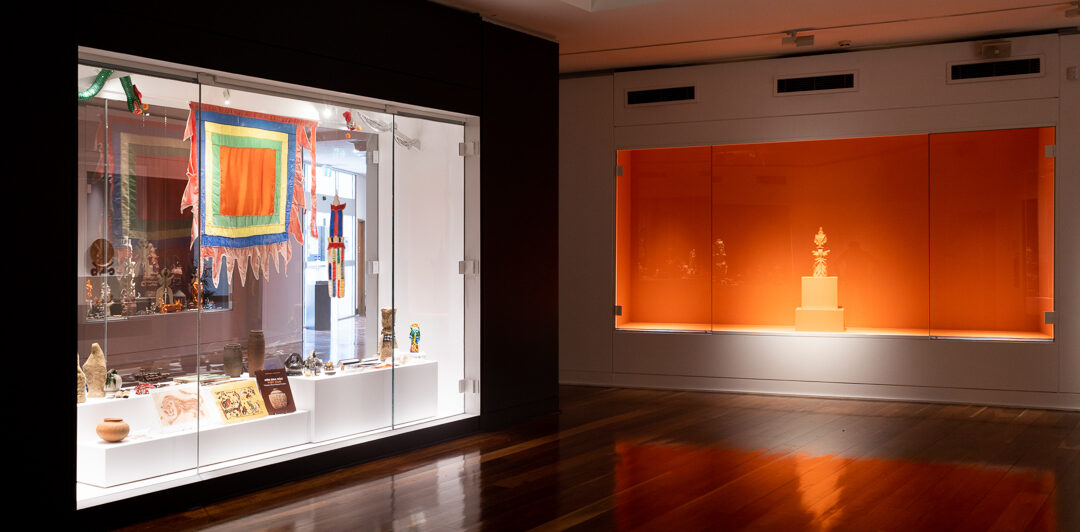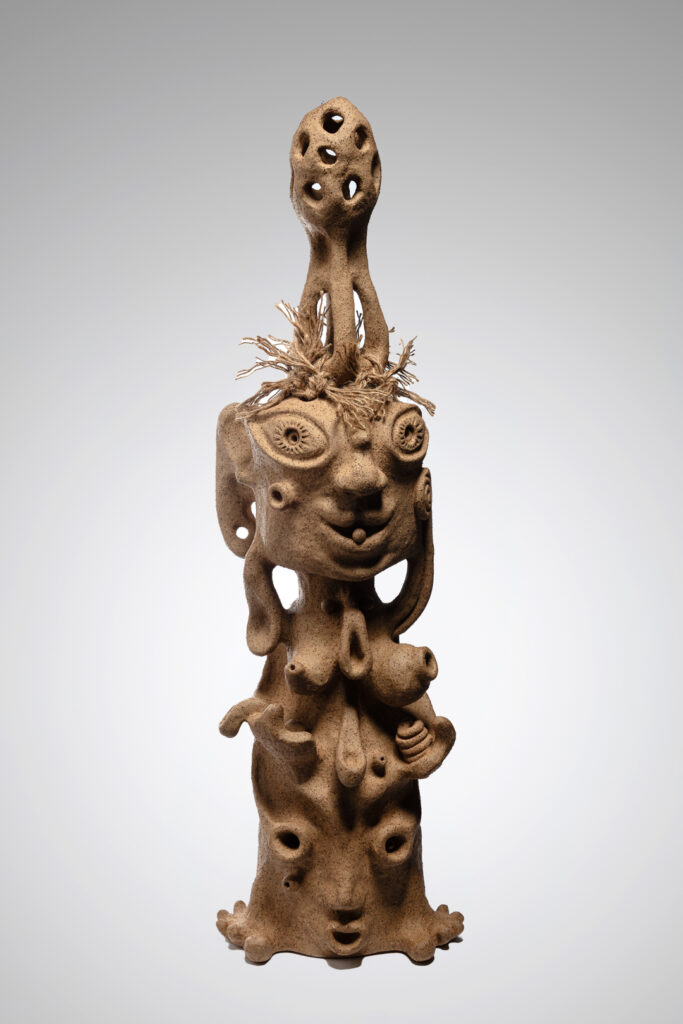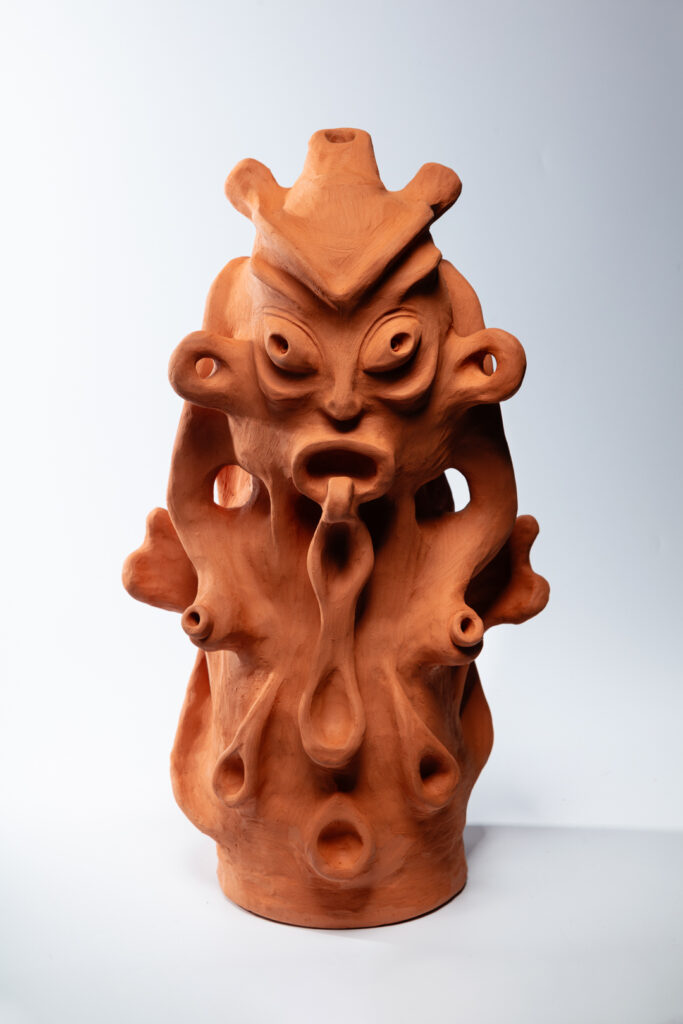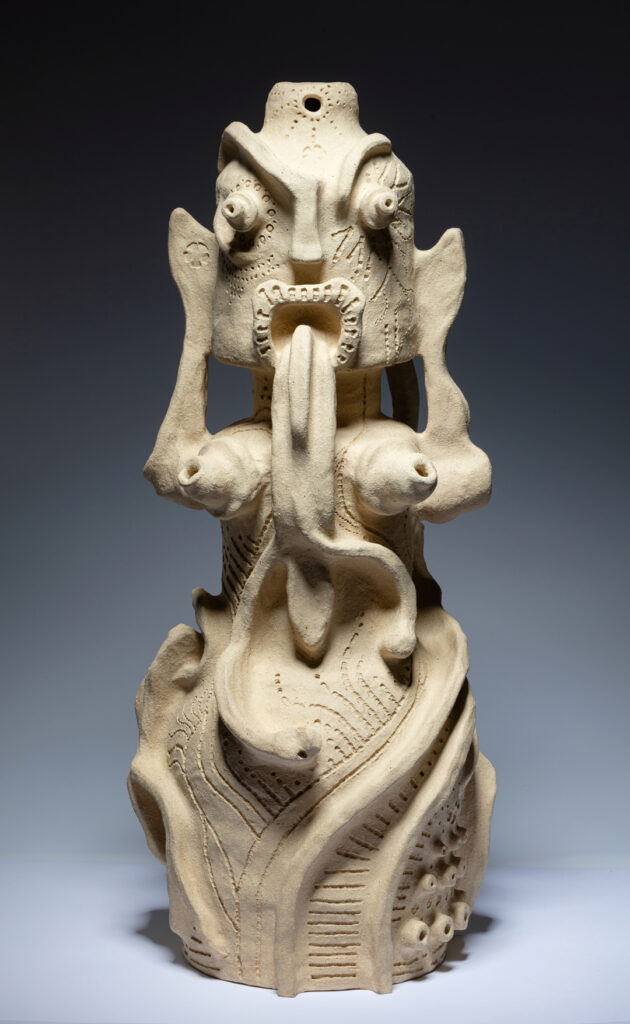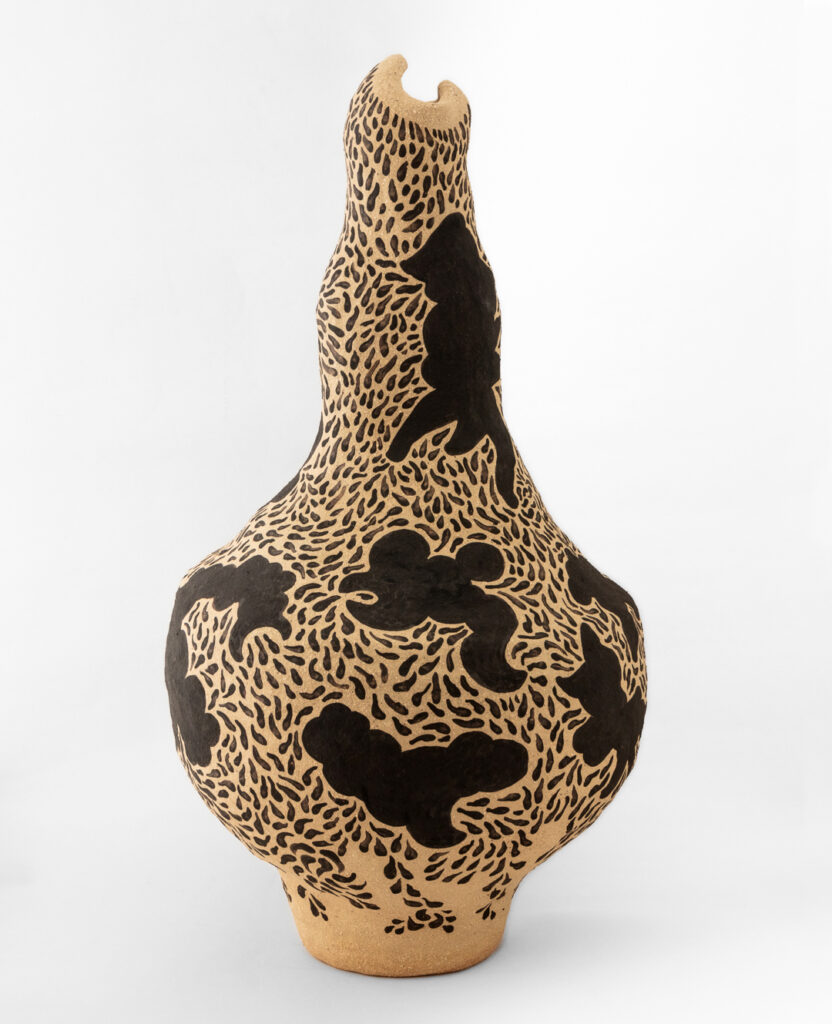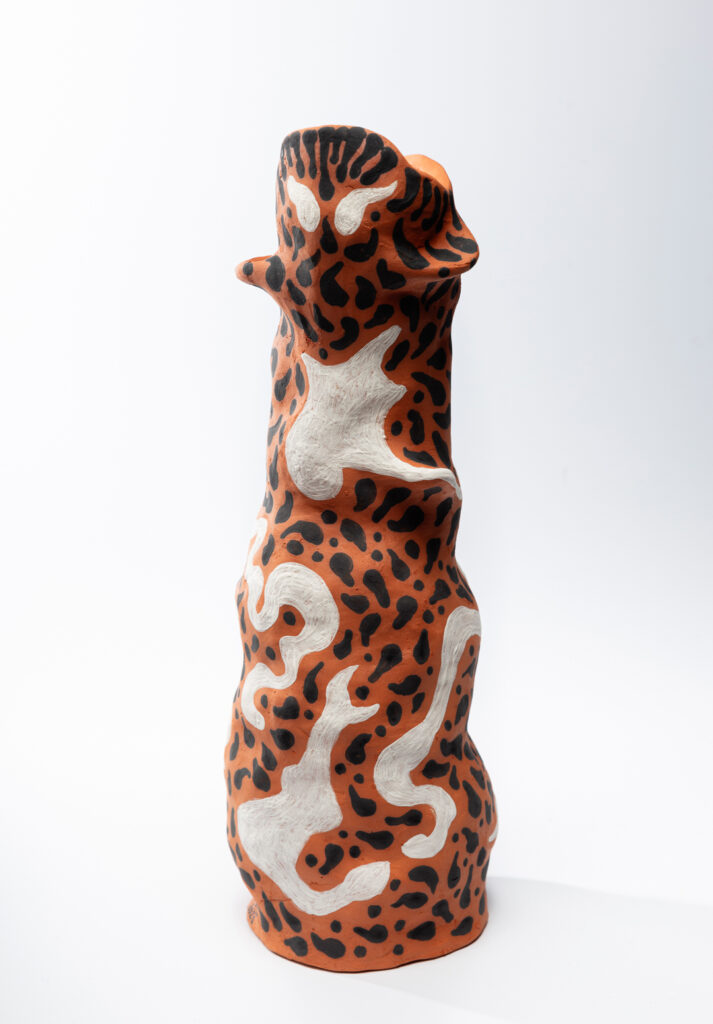Mai Nguyễn-Long introduces her Kôgábịnô exhibition, featuring works that express the Vietnamese punk-like aesthetic of mộc mạc.
At the Berlin Biennale (2022), Vomit Girl was Kotzmädchen or “puke girl”; In Hanoi, she has been described as cô gái buồn nôn or “nauseous girl”. To me, she is cô gái bị nôn or “girl vomiting”. Drawing from these variations of mistranslation and wordplay, common to contemporary global exchanges, Vomit Girl’s new alter-moniker is Kôgábịnô. Hidden and multiple identities, mistranslations and reinterpretations are concepts woven throughout my practice, alongside ideas of colonisation, decolonisation and recolonisation. Vomit Girl compelled me to reconnect with Vietnam and announce an affection for đình woodcarvings, a connection I had previously thought too dangerous in Australia.1.Nguyễn-Long, Mai. “Vomit Girl Beyond Diasporic Trauma: Interconnecting Contemporary Art and Folkloric Practices in Vietnam.” Doctor of Creative Arts thesis, School of the Arts, English and Media, University of Wollongong, 2022. https://ro.uow.edu.au/theses1/1510.
I was drawn to the museum-style cabinets of the Mann-Tatlow Gallery (MTG) in Wollongong Art Gallery (WAG) for its shrine-like/pagoda-vitrine references. Working with objects behind glass relates to my ongoing Specimen jar series2.Specimen (2014) in “Beyogmos.” Solo exhibition curated by Gina Fairley, Wollongong Art Gallery, Wollongong, 28 February-25 May 2014; Specimen (Permeate) 2022 in “The 12th Berlin Biennale for Contemporary Art.” Group exhibition curated by Kader Attia, Akademie Der Künste, Hanseatenweg, Berlin, 11 June-18 September 2022; Skippy Subcluster (2023) in “What’s that Skip?” Group exhibition curated by Miriam Williamson and Leah Haynes, Wayout Artspace, Kandos, 19 August-1st October 2023. ; and a recurring sensation of being trapped behind glass, perpetually screaming but unheard.
The MTG was specifically designed to house the WAG Mann Tatlow Collection of Asian Art. However, the collection’s apparent absence of artefacts from Vietnam3.On 30 August 2023, the Mann-Tatlow inventory of 226 entries indicates object accession numbers 2003.035 and 2003.239 are attributed to China. However, citing Kerry Nguyễn-Long, Louise Brand explains new expertise suggests that both these ceramic artefacts are in fact Vietnamese. At the time of writing this essay, Brand confirmed WAG is working towards formally acknowledging this reclassification. echoes my life experience. My sense of invisibility and irrelevance had been exacerbated when, as a tertiary student in 1990s Australia, I found it impossible to source any information about art from Vietnam.
The ‘Kôgábịnô’ exhibition disrupts this sense of erasure. It also serves to footnote pre-Vietnam War social exchange between Vietnam and Australia through my parents’ cross-cultural marriage. Kerry Nguyễn-Long4.Kerry Nguyễn-Long and Nguyễn Kim Long are my parents. and Đỗ Mỹ Thiện’s research, alongside Nguyễn Kim Long’s photo archive, have provided me with a counterbalance to devastation by opening a portal for a different kind of knowing. However, my commitment to engagement with Vietnam has at times faced vicious opposition. Uncannily reflecting my Vomit Girl, such trauma-informed vitriol is alluded to in a Sydney Morning Herald article quoting a protestor’s impulse to “vomit”5.Gibbs, Stephen. “Thousands protest as SBS considers bulletin’s fate.” The Sydney Morning Herald, News, Wednesday, 3 December 2003:—but with oppositional triggers to my own.
There are a host of rational and imagined reasons for my sense that Vietnam’s art history has been neglected from multiple contexts, both in and outside of Vietnam. Amongst these are French colonisation, the Vietnam/American/Cold War, Australia’s Asia literacy deficit, anticommunism inextricably bound with trauma and prejudice, Sinocentric narratives, and loss of language or “mother tongue”. All these have informed my sense of shame. To counter the colonising power of this shame and its associated traumas, my clay works declare the embrace of shame and a celebration of marginality.
Historical and family artefacts provide hints for decoding a reading of my clay “deities”. Juxtaposing Tasmanian/Vietnamese, old/new, public/personal, communist/anticommunist, Chinese/Vietnamese artefacts opens messy and uncomfortable spaces.
- Mai Nguyễn-Long; photo: Bernie Fischer
- Mai Nguyễn-Long; photo: Bernie Fischer
- Mai Nguyễn-Long; photo: Bernie Fischer
- Mai Nguyễn-Long; photo: Bernie Fischer
- Mai Nguyễn-Long; photo: Bernie Fischer
- Mai Nguyễn-Long; photo: Michael Reid Gallery
- Mai Nguyễn-Long; photo: Bernie Fischer
My clay sculptures are mediums for deliberating the Vietnamese aesthetic of “mộc mạc”. The book that first introduced me to the term mộc mạc6.Nguyễn, Đỗ Cung. Việt Nam: Điêu khắc dân gian thế kỷ XVI – XVII – XVIII [Vietnam: Popular Sculpture 16th – 17th – 18th Centuries]. Hà Nội: Nhà Xuất Bản Ngoại Văn [Foreign Languages Publishing House], 1975. vii Nguyễn-Long, Mai. “Vomit Girl Beyond Diasporic Trauma. is but one sampling of cultural resources that suggest further depth and richness lies untapped. Mộc mạc is literally ‘earthy.’ However, I’ve formulated it through my creative practice as an aesthetic of resistance, a practical primordial essence incorporating elements of play and a fluid resistance to shifting forms of domination.7.Nguyễn-Long, Mai. “Vomit Girl Beyond Diasporic Trauma.”
This guides my building with clay, processing village đình sensations through my Worana (worm-dragon-snake) coil-building method and conceptual Doba. Doba is the cylindrical form of a disused bombshell repurposed as a village bell.
Dobakapi is my big belly clay jar form deriving from the “1450 Topkapi Jar,”8.Nguyễn-Long, Kerry. Vietnam Visual Arts in History Religion & Culture. Hà Nội: Thế Giới Publishers, 2023. Page 26 explains how in 1977 this ceramic vessel in the Topkapi Sarai Museum, Istanbul, was established to have been made in Vietnam. an artefact that was misidentified as Chinese for 500 years. Reclassification as a Vietnamese artefact opened appreciation of new histories of trade and understanding of Vietnamese wares. The punctuation of hot orange amongst unglazed forms breaks up the hegemony of an earthy aesthetic, acknowledging that every notion of decolonisation risks recolonisation—a condition of perpetual doubt. Orange signifies the destructive chemical Agent Orange and simultaneously serves as an incantation for collapsed binaries.
Some resonances playfully vibrating across the objects for me includes empty bullet shells I collected from a refugee camp on Vietnam’s border with Cambodia; my self-harm kit; a warplane metal ruler made by my uncle in a re-education camp. The three stripes of the “Freedom Flag” in a Sydney Morning Herald article is mirrored in multi-stripes on the now-extinct Tasmanian tiger, a huon pine carving gifted to me by my late Tasmanian grandmother. My late Vietnamese grandmother is remembered through a Khmer Krom9. The Khmer Krom are indigenous peoples of the Mekong Delta in Vietnam. Source: Walker, Julie. “Khmer Krom strive to preserve their cultural heritage in Viet Nam.” United Nations News: Global Perspectives in Human Stories (17 May 2012). Accessed 26 August 2023. https://news.un.org/en/audio/2012/05/573442. ritual earthenware, the likeness of which was smashed to protect her soul from evil spirits. Cultural practices of flag-waving are echoed in đình festival flags, ripped and faded by the harsh Aussie sun. Statues10.(1) Bust of Hồ Chí Minh (2) Virgin Mary standing on a snake (3) Dancing water puppet fairy. are secreted in hessian to acknowledge stories forever untold. The narratives in my drawings abstrusely contend with the fallout from these colliding histories.
Other artefacts include Dakao high-heeled shoes worn by a 1960s Vietnamese Colombo Plan student to Tasmania, and limepots particular to rites of passage–early objects from Mum’s research archive (Nguyễn-Long, Kerry. “Vietnamese Limepots.” Arts of Asia 27, no. 5 (1997): 66-77.)). Toads in a Đông Hồ print, metaphorically critiquing hollow authority within the education system are echoed in a toad-shaped ceramic artefact from my parent’s collection. Toads are potent symbols in Vietnamese folklore. On Đông Sơn drums they call for rain. These agrarian roots inform iterations of Vomit Girl as Vigit Hefeco, with what I affectionately refer to as “poo balls” in his/her hands, honouring the collection of manure as fertiliser. At the same time, 1,000 of these balls reference 1,000 years of Chinese domination. Here, poo balls might be ammunition. Water and fluidity define my relationship with clay, and a water puppet likewise speaks to the prevalence of watery folkloric practices; dimpled reflective surfaces suggest mirror devices for mediumship transformation11.Hoskins, Jane. “The Spirits You See in the Mirror: Spirit Possession in the Vietnamese American Diaspora.” In The Southeast Asian Diaspora in the United States, edited by Jonathan H.X. Lee, Chapter 4, 73-100. Cambridge: Cambridge Scholars Press, 2014. , and are a homage to my 1996 artwork Child Bride Rising–an imagined ascendancy of domination. The empty cabinet invites attribution to one’s personal deities perhaps remotely located.
Kôgábịnô does not offer resolutions to conflict and contradiction but is part of a larger process of agitation and repair. Vomit Girl’s yearning for connectivity is coupled with a mistrust of belonging. Cultural specificity is tempered through the materiality of clay, my sculptural forms ever-evolving through an ongoing conversation with artefacts. Kôgábịnô aka Vomit Girl hosts my imaginary army of spirits, my weapons of spiritual resilience, detoxing and fending off imminent annihilation.
✿
Mai Nguyễn-Long is represented by Michael Reid Sydney + Berlin . Visit www.mai-long.com and follow @mainguyenlong.
Kôgábịnô Wollongong Art Gallery 21 October 2023 – 7 April 2024; curated by Adam Porter
References
| ↑1 | Nguyễn-Long, Mai. “Vomit Girl Beyond Diasporic Trauma: Interconnecting Contemporary Art and Folkloric Practices in Vietnam.” Doctor of Creative Arts thesis, School of the Arts, English and Media, University of Wollongong, 2022. https://ro.uow.edu.au/theses1/1510. |
|---|---|
| ↑2 | Specimen (2014) in “Beyogmos.” Solo exhibition curated by Gina Fairley, Wollongong Art Gallery, Wollongong, 28 February-25 May 2014; Specimen (Permeate) 2022 in “The 12th Berlin Biennale for Contemporary Art.” Group exhibition curated by Kader Attia, Akademie Der Künste, Hanseatenweg, Berlin, 11 June-18 September 2022; Skippy Subcluster (2023) in “What’s that Skip?” Group exhibition curated by Miriam Williamson and Leah Haynes, Wayout Artspace, Kandos, 19 August-1st October 2023. |
| ↑3 | On 30 August 2023, the Mann-Tatlow inventory of 226 entries indicates object accession numbers 2003.035 and 2003.239 are attributed to China. However, citing Kerry Nguyễn-Long, Louise Brand explains new expertise suggests that both these ceramic artefacts are in fact Vietnamese. At the time of writing this essay, Brand confirmed WAG is working towards formally acknowledging this reclassification. |
| ↑4 | Kerry Nguyễn-Long and Nguyễn Kim Long are my parents. |
| ↑5 | Gibbs, Stephen. “Thousands protest as SBS considers bulletin’s fate.” The Sydney Morning Herald, News, Wednesday, 3 December 2003: |
| ↑6 | Nguyễn, Đỗ Cung. Việt Nam: Điêu khắc dân gian thế kỷ XVI – XVII – XVIII [Vietnam: Popular Sculpture 16th – 17th – 18th Centuries]. Hà Nội: Nhà Xuất Bản Ngoại Văn [Foreign Languages Publishing House], 1975. vii Nguyễn-Long, Mai. “Vomit Girl Beyond Diasporic Trauma. |
| ↑7 | Nguyễn-Long, Mai. “Vomit Girl Beyond Diasporic Trauma.” |
| ↑8 | Nguyễn-Long, Kerry. Vietnam Visual Arts in History Religion & Culture. Hà Nội: Thế Giới Publishers, 2023. Page 26 explains how in 1977 this ceramic vessel in the Topkapi Sarai Museum, Istanbul, was established to have been made in Vietnam. |
| ↑9 | The Khmer Krom are indigenous peoples of the Mekong Delta in Vietnam. Source: Walker, Julie. “Khmer Krom strive to preserve their cultural heritage in Viet Nam.” United Nations News: Global Perspectives in Human Stories (17 May 2012). Accessed 26 August 2023. https://news.un.org/en/audio/2012/05/573442. |
| ↑10 | (1) Bust of Hồ Chí Minh (2) Virgin Mary standing on a snake (3) Dancing water puppet fairy. |
| ↑11 | Hoskins, Jane. “The Spirits You See in the Mirror: Spirit Possession in the Vietnamese American Diaspora.” In The Southeast Asian Diaspora in the United States, edited by Jonathan H.X. Lee, Chapter 4, 73-100. Cambridge: Cambridge Scholars Press, 2014. |

